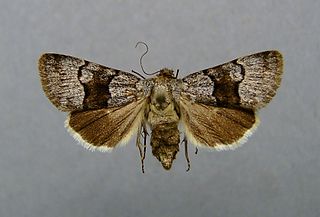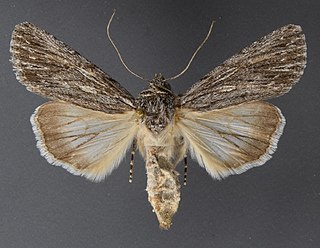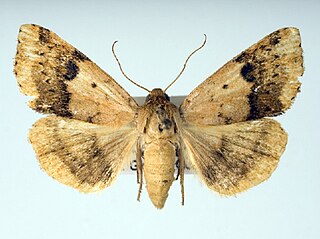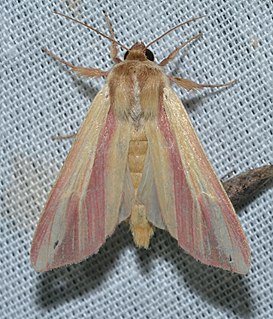
Hemaris gracilis, the slender clearwing or graceful clearwing, is a moth of the family Sphingidae. The species was first described by Augustus Radcliffe Grote and Coleman Townsend Robinson in 1865.

Acronicta lanceolaria, the lanceolate dagger moth or pointed dagger, is a moth of the family Noctuidae. The species was first described by Augustus Radcliffe Grote in 1875. It is found in North America, from Nova Scotia to British Columbia. It is listed as a species of special concern and believed extirpated in the US state of Connecticut.

Sympistis is a genus of moths of the family Noctuidae. The genus was erected by Jacob Hübner in 1823.

Sympistis aqualis is a moth of the family Noctuidae first described by Augustus Radcliffe Grote in 1881. It is found in North America. It was formerly considered a subspecies of Oncocnemis riparia, but was elevated to species status and transferred to the genus Sympistis in 2008.
Sympistis aterrima is a moth of the family Noctuidae first described by Augustus Radcliffe Grote in 1879. It is found in North America, including California.
Sympistis chorda is a moth of the family Noctuidae first described by Augustus Radcliffe Grote in 1880. It is found in North America from British Columbia, south to California. It was formerly known as Oncocnemis chorda, but was transferred to the genus Sympistis in 2008.

Sympistis major is a moth of the family Noctuidae first described by Augustus Radcliffe Grote in 1881. It is widely distributed in the Pacific Northwest of North America. It was formerly known as Oncocnemis riparia major, a subspecies of Oncocnemis riparia, but was elevated to species level as Oncocnemis major in 1999 and transferred to the genus Sympistis in 2008.
Sympistis figurata is a moth of the family Noctuidae first described by Leon F. Harvey in 1875. It is found in the United States east of the Cascade Range in Washington and Oregon.

Sympistis glennyi is a moth of the family Noctuidae first described by Augustus Radcliffe Grote in 1873. It is found in western North America from the mountains of southern Alberta west to British Columbia and south at least to Colorado and California.

Acronicta falcula, the corylus dagger moth, is a moth of the family Noctuidae. The species was first described by Augustus Radcliffe Grote in 1877. It is found in the United States and Canada from southern New England to southern Manitoba and Iowa. Recently seen from Wisconsin, Connecticut, Rhode Island, New York and Michigan. It is reported as rare in Ohio. It is listed as a species of special concern in the US state of Connecticut.

Apamea inordinata is a moth of the family Noctuidae. It is found in the United States, including New York, Massachusetts, Pennsylvania, Colorado, and California. In Canada it is found in Ontario, Quebec, New Brunswick, Nova Scotia, British Columbia, Alberta, Saskatchewan and Manitoba. Its wingspan is about 34 mm. The species is listed as threatened in Connecticut.

Heliocheilus lupatus, the purple topper, lupatus straw moth or spotted straw moth, is a moth in the family Noctuidae. The species was first described by Augustus Radcliffe Grote in 1875. It is found in the United States from Kentucky and central Connecticut south to Florida and Texas.

Melitara dentata, the North American cactus moth, is a moth of the family Pyralidae. The species was first described by Augustus Radcliffe Grote in 1876. It is native to western North America, where it is widespread from Alberta to southern Arizona and central Texas. It is an introduced species in Hawaii.
Coranarta luteola is a moth of the family Noctuidae described by Augustus Radcliffe Grote and Coleman Townsend Robinson in 1865. It is found in the boreal zone of North America, from Alaska to Labrador. Its range extends south to Minnesota and Wisconsin in the Midwest and to Maine in the east. In the Rocky Mountains, it extends as far south as Colorado. It is listed as endangered in the US state of Connecticut.

Dargida rubripennis, the pink streak, is a species of moth in the family Noctuidae. It was described by Augustus Radcliffe Grote and Coleman Townsend Robinson in 1870. It is found in the eastern United States, ranging to Kansas and Texas. It is listed as threatened in the US states of Massachusetts and Connecticut. The wingspan is 32–37 mm. The forewings are yellowish-white, with dull pink streaks and shaded with dull pink at the outer margin. The hindwings are white, also shaded with dull pink. Adults are on wing from January to February and from July to October. Its preferred larval host plant is Switchgrass.

Sympistis infixa, the broad-lined sallow moth, is a moth in the family Noctuidae. It was described by Francis Walker in 1856 and is found in North America.
Sympistis perscripta, the scribbled sallow moth is a moth of the family Noctuidae that is native to North America. It is listed as a species of special concern in the US states of Connecticut and Massachusetts. It was described by Achille Guenée in 1852. The larval hosts are Antirrhinum, Linaria, and Nuttallanthus.
Sympistis kelsoensis is a species of moth in the family Noctuidae. It is found in North America.

Sympistis riparia, the dune sympistis, is a moth of the family Noctuidae. The species was first described by Herbert Knowles Morrison in 1875. It is native to North America and it is listed as a species of special concern in Massachusetts and in Connecticut.









